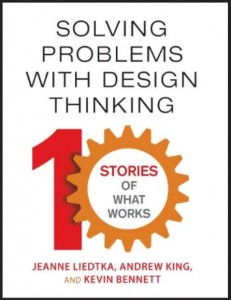One of my favorite books of recent years, Designing for Growth: A Design Thinking Toolkit for Managers was co-authored by Jeanne Liedtka. Her co-author Tim Ogilvie, CEO of innovation strategy consultancy Peer Insight was a past podcast guest and I highly recommend both the podcast and the book. Transcription with Podcast link: Using Design Thinking for Growth.
In Jeanne’s most recent book, Solving Problems with Design Thinking, she tells a story on how Toyota redesigned the customer contact center using Design Thinking. Most of us know about the legendary Toyota Production System, the precursor to Lean Manufacturing, and would think that the use of Design Thinking may be symbolic at best. They already have the best change management system on the planet, don’t they? In my understanding of Toyota, it certainly seems that they are willing to evaluate and look at most options. They are willing to adapt, which by the way is the most predominant trait needed in any species to survive. Excerpt from the book:
Change management at Toyota included identifying all stakeholders and what they needed to know, do, or own; communicating; training; and testing. Toyota’s past experiences had demonstrated that this approach to change management, though a significant effort, gave projects a chance to succeed. Without it, they tended to fail because people didn’t feel a sense of ownership, and, therefore, did not adopt the change.
In the chapter, the authors discuss three integral people as part of the process; Elaine, Gayle and Diane. Elaine being part of the Customer Contact Center, Gayle a change expert at the University of Toyota (the company’s in-house training center), and Diane team an external consultant with Hitachi Consulting, a global IT consulting firm.
One of the Design Tools discussed as part of this effort was ethnography. Excerpt from the book:
Ethnography Isn’t Only for Customers: The idea of diving deep into customers’ perspectives seems obvious to most businesspeople. We often fail, however, to apply ethnographic tools to our internal partners and stakeholders. Their support is essential to the success of our innovation efforts, and understanding their problems and needs can often be as valuable as understanding customers’. Gayle’s efforts to understand the reps’ daily lives provides a strong foundation for the redesign of the Contact Center process.
The first thing Gayle did was go through the contact center training to get an understanding of the existing issues that the service reps had. She did not just observe; she participated. Gayle became part of the team through her actions to “go look, go see or as it is called in Japanese and the Lean world, Genchi Genbutsu.
The chapter go on to explain the successful outcome derived from both Design Thinking and the adaptable of the Toyota Culture with key takeaways of respect for people. Lean people may not find any of this surprising. However, i found it refreshing to see the application explained from the Design Thinking perspective. The power of Genchi Genbutsu or as my friend Bob Petruska explains in Gemba Walks for Service Excellence: The Step-by-Step Guide for Identifying Service Delighters, it is the power of being at the point of use that is so important. The concept that customer service can be done digitally without the context of use, may limit our ability to grow as an organization.
I also found it fascinating that Toyota used three different perspectives in solving the problem. They brought both an internal and external consultant to the table with the users. I am looking forward to reading the rest of Solving Problems with Design Thinking. I started on this chapter and have read it twice now!
Want to learn more about Design Thinking and Lean? Lean Service Design Presentation at ASQ.
